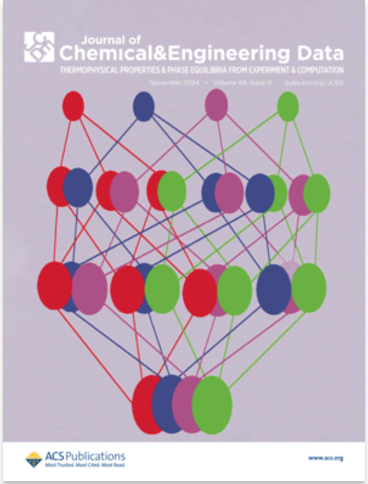一项评估利用循环肿瘤 DNA (ctDNA) 对晚期/转移性结直肠癌 (mCRC) 治疗进行定制的随机研究:TACT-D。
IF 2.1
3区 工程技术
Q3 CHEMISTRY, MULTIDISCIPLINARY
Journal of Chemical & Engineering Data
Pub Date : 2024-06-10
DOI:10.1200/jco.2024.42.17_suppl.lba3557
引用次数: 0
摘要
LBA3557 背景:昂贵的挽救性疗法疗效不佳且存在大量治疗相关不良事件(TRAEs)(如瑞戈非尼 [Reg] 或 TAS102 [Tas],用于 mCRC),识别对这些疗法无应答者是精准治疗的关键。回顾性研究表明,在放射学评估之前的时间点(治疗 4-10 周[wks])的 ctDNA 变化可预测治疗结果。然而,目前还缺乏评估早期ctDNA变化的前瞻性研究,临床效用仍不确定。方法:TACT-D 是一项随机研究:TACT-D是一项随机研究,旨在验证ctDNA的早期动态变化(ΔctDNA:最大变异等位基因频率(maxVAF)或平均VAF在预测治疗反应/耐药性方面的变化)。临床上符合Reg/Tas治疗条件的mCRC患者(pts)被2:1随机分配到标准治疗(SOC)或ctDNA治疗组。所有患者均在第1周期第1天(C1D1)和C1D15通过Guardant360 CDx测定进行ctDNA测序。在 SOC 治疗组,受试者在 8 周时重新分期。在ctDNA组,ΔctDNA(C1D15 - C1D1)实时运行,ctDNA的增加(ΔctDNA > 0)触发早期放射学重新分期。对有反应者(RECISTv1.1 稳定疾病/有反应)继续治疗,对病情进展者(无反应者)停止治疗。共同主要终点是1)各研究臂之间的 TRAEs 比较;2)ΔctDNA 与客观反应率 (RR) 的关系。主要次要终点为无进展生存期(PFS)和总生存期(OS)。研究的有效率(82%;双侧 α = .05)可检测到毒性降低 30%。研究结果2019年4月至2023年8月,100名患者接受了随机治疗;80名可评估患者的中位年龄为56岁,46%为女性,44%和56%分别接受了Tas和Reg治疗。基线ctDNA水平(ρ 0.90)和ΔctDNA(ρ 0.68)使用最大VAF(报告如下)和平均VAF显示出很强的相关性(P < .001)。整个队列的中位 ΔctDNA 为 -47%,不同治疗臂(SOC -45% v Exp -58%,P = .79)和疗法(Tas -71 v Reg -44,P = .19)之间无显著差异。18%的患者ΔctDNA增加。3/4 级 TRAEs(32% 对 40%,P = .62)在不同治疗组之间无显著差异。ΔctDNA与RR(OR .88,P = 1.0)、PFS(HR .99,P = .88)和OS(HR 1.00,P = .64)之间无明显关联。值得注意的是,较高的基线 maxVAF 与应答(中位数 maxVAF:无应答者 21.8% 对应答者 3.4%)、PFS(HR 1.02)和 OS(HR 1.03)密切相关(均 P < .001)。调整基线 maxVAF 后,发现 ΔctDNA 与 PFS(HR 1.87,P = .038)和 OS(HR 3.55,P = .001)相关。结论在第一项监测mCRC中ctDNA临床效用的前瞻性研究中,基线ctDNA对mCRC挽救疗法的临床获益具有很强的预后作用。对这种预后影响进行调整后,C1D1和C1D15之间的ΔctDNA可预测临床结果。需要努力建立新的特征、最佳临界值/间隔,以评估mCRC的ctDNA反应,并为患者及其治疗量身定制。临床试验信息:NCT03844620 .本文章由计算机程序翻译,如有差异,请以英文原文为准。
A randomized study evaluating tailoring of advanced/metastatic colorectal cancer (mCRC) therapy using circulating tumor DNA (ctDNA): TACT-D.
LBA3557 Background: Identifying non-responders to expensive salvage therapies with modest benefits and substantial treatment related adverse events (TRAEs) (e.g. regorafenib [Reg] or TAS102 [Tas] in mCRC) is key to precision care. Retrospective studies suggest that ctDNA changes at timepoints (4-10 weeks [wks] into therapy) before radiographic assessment may predict treatment outcomes. However, prospective studies assessing early ctDNA changes are lacking and clinical utility remains uncertain. Methods: TACT-D is a randomized study to validate early dynamic changes in ctDNA (ΔctDNA: change in either maximum variant allele frequency (maxVAF) or mean VAF in predicting treatment response/resistance. Patients (pts) with mCRC clinically eligible for Reg/Tas were randomly assigned 2:1 to either standard of care (SOC) or ctDNA arm. All pts had ctDNA sequencing by Guardant360 CDx assay on cycle 1 day 1 (C1D1) and C1D15. On SOC arm, pts were restaged at 8 wks. On ctDNA arm, ΔctDNA (C1D15 - C1D1) was run in real-time and increase in ctDNA (ΔctDNA > 0) triggered early radiographic restaging. Therapy was continued for responders (RECISTv1.1 stable disease/response) and stopped for progression (non-responders). Co-primary endpoints were: 1) comparison of TRAEs among study arms and 2) association of ΔctDNA and objective response rate (RR). Key secondary endpoints were progression free (PFS) and overall (OS) survival. Study was powered (82%; 2-sided α = .05) to detect 30% decrease in toxicity. Results: Between 4/2019 and 8/2023, 100 pts were randomized; 80 evaluable had median age of 56 years, 46% were females, 44% and 56% received Tas and Reg, respectively. Baseline ctDNA levels (ρ 0.90) and ΔctDNA (ρ 0.68) using maxVAF (reported below) and mean VAF showed strong correlation (P < .001). Median ΔctDNA for entire cohort was -47% with no significant difference by treatment arms (SOC -45% v Exp -58%, P = .79) and therapy (Tas -71 v Reg -44, P = .19). ΔctDNA increased in 18% pts. Grade 3/4 TRAEs (32% v 40%, P = .62) did not differ significantly between arms. No significant association was seen between ΔctDNA and RR (OR .88, P = 1.0), PFS (HR .99, P = .88) and OS (HR 1.00, P = .64). Notably, higher baseline maxVAF was strongly associated with response (median maxVAF: 21.8% in non-responders v 3.4% in responders), PFS (HR 1.02) and OS (HR 1.03) (all P < .001). After adjusting for baseline maxVAF, ΔctDNA was found to be associated with both PFS (HR 1.87, P = .038) and OS (HR 3.55, P = .001). Conclusions: In the first prospective study of clinical utility of monitoring ctDNA in mCRC, baseline ctDNA was strongly prognostic for clinical benefit from salvage therapies in mCRC. Adjusted for this prognostic impact, ΔctDNA between C1D1 and C1D15 was predictive of clinical outcomes. Efforts are needed to establish novel signatures, optimal cutoffs/intervals for assessing ctDNA response in mCRC, tailored to pts and their therapy. Clinical trial information: NCT03844620 .
求助全文
通过发布文献求助,成功后即可免费获取论文全文。
去求助
来源期刊

Journal of Chemical & Engineering Data
工程技术-工程:化工
CiteScore
5.20
自引率
19.20%
发文量
324
审稿时长
2.2 months
期刊介绍:
The Journal of Chemical & Engineering Data is a monthly journal devoted to the publication of data obtained from both experiment and computation, which are viewed as complementary. It is the only American Chemical Society journal primarily concerned with articles containing data on the phase behavior and the physical, thermodynamic, and transport properties of well-defined materials, including complex mixtures of known compositions. While environmental and biological samples are of interest, their compositions must be known and reproducible. As a result, adsorption on natural product materials does not generally fit within the scope of Journal of Chemical & Engineering Data.
 求助内容:
求助内容: 应助结果提醒方式:
应助结果提醒方式:


